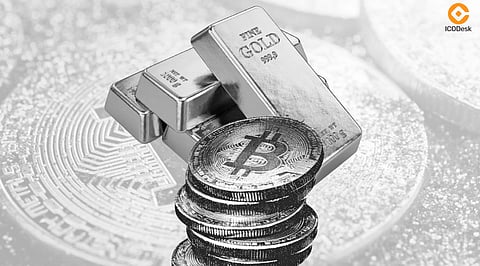

Throughout 2025, gold’s rally has surprised many observers. While Bitcoin and other digital assets have drawn headlines for their volatility and innovation, gold has quietly outpaced them across several key metrics — a performance shift that is reshaping how investors view traditional vs. digital stores of value. From surging central bank demand and macro instability to regulatory headwinds in crypto, the yellow metal is flexing strength in areas where Bitcoin appears vulnerable.
Below, we dive into why gold is beating bitcoin, what it means for asset allocation, and whether this advantage is likely to persist.
Market stress, geopolitical uncertainty, and inflation fears tend to push capital toward assets with perceived stability. In 2025, that pattern has favored gold in a big way:
Gold has crossed $4,000 per ounce for the first time, posting sharp gains year-to-date.
Unlike Bitcoin, gold is a well-understood and time-tested safe-haven instrument. In times of fear or uncertainty, investors often default to it.
Central banks are aggressively increasing gold reserves. This institutional demand offers a structural backbone to the rally.
Real (inflation-adjusted) interest rates have been under pressure, reducing the opportunity cost of holding non-yielding assets like gold.
Bitcoin has benefited from some of the same macro forces — weak dollar, inflation hedging narratives, institutional flows — but gold’s longer history as a safety anchor gives it a credibility edge during turbulence.
One structural advantage gold possesses is sheer scale and liquidity:
The gold market (including physical, futures, ETFs) is deeply established, with vast global capital flows.
Bitcoin, while increasingly liquid, is still smaller in overall market cap and more sensitive to flows, regulatory changes, and sentiment shifts.
Gold can absorb large purchases with less slippage; Bitcoin can spasm under large orders or margin/liquidation cascades.
Because gold’s market infrastructure is mature — with major exchanges, derivatives markets, and institutional access — it has fewer friction points when capital rotates in or out.
Bitcoin’s upside is often entangled with regulatory uncertainty and structural risks:
Governments and regulators worldwide are still grappling with how to classify, tax, or regulate crypto. Sudden crackdowns, bans, or unfavorable rulings can spook markets.
Crypto infrastructure — exchanges, wallets, Layer-2 systems — faces hacking, software bugs, and governance vulnerabilities.
Some institutional investors may hesitate to fully commit to crypto due to custody, compliance, or regulatory transparency issues.
Gold, by contrast, is a known quantity in regulation, taxation, and institutional frameworks. It doesn’t face periodic existential risk from new laws or bans.
Markets tend to favor what’s already working — momentum begets further momentum:
As gold started outperforming, more investors shifted capital into it, reinforcing the trend.
Some capital that might have looked at Bitcoin is being diverted to gold, especially from cautious or risk-averse investors.
The narrative shift matters: gold is once again being framed not just as relic or inflation hedge, but as a modern anchor in uncertain times.
Crypto markets are prone to speculative rotations — one day altcoins lead, the next, a sector pullback. Gold’s more stable upward trajectory attracts “safe profit” capital.
In short: once gold’s outperformance becomes a visible trend, the migration of capital can amplify its lead over more volatile alternatives.
Gold’s current edge is not guaranteed to last indefinitely. Some counterpoints and risks:
Overextension & technical pullbacks: Gold’s rapid gains raise the risk of corrections or consolidation, especially if momentum fades.
Bitcoin’s asymmetric upside: While more volatile, Bitcoin still carries the potential for far larger percentage moves upward in bull phases.
Technological breakthroughs or policy clarity in crypto could reignite interest and shift capital back.
Macro pivots: If rates rise aggressively or inflation is tamed quickly, assets like Bitcoin might outperform due to higher growth exposure.
Sentiment reversal: If risk appetite returns strongly, capital may rotate back into growth / innovation assets like crypto.
Diversification matters: Gold’s current lead argues for including precious metals alongside crypto in balanced portfolios.
Mind allocation timing: Avoid committing heavily to Bitcoin only because it’s “the future”— but also avoid dismissing its long-term potential.
Monitor catalysts: Regulatory developments, macro policy shifts, central bank buying or selling, and crypto network updates will all influence direction.
Scale your exposure: Allocate in tiers — base “anchor” positions (gold, stable assets) and satellite bets (digital assets, altcoins) with proper risk controls.
Use pullbacks as opportunities: If gold corrects, or if crypto weakens, that might offer re-entry points.
Gold is currently outperforming Bitcoin in 2025 for a confluence of reasons: its historical safe-haven status, deep liquidity and scale, structural regulatory advantages, and growing investor momentum. While Bitcoin still carries appeal, especially for high upside in growth cycles, gold is enjoying the upper hand in this phase. Rather than viewing this as a binary matchup, the smarter strategy may lie in embracing both, allocating to each in balance with risk tolerance and long-term conviction.